South American Camelids

South American Camelids (SACs) include the llama, guanaco, alpaca and vicuna. All camelids (including camels) have a karyotype (chromosomes) of 2n=74 and all have produced fertile crosses. The anatomy of all camelids is similar. While camels evolved to cope with heat and dehydration faced in the Asian and African climates, SACs evolved to cope with high altitude and cooler temperatures of the Andean Mountains. Aside from these differences, they share similar biology. They have a complex 3-compartmented stomach which is similar to that of a ruminant (such as a sheep) in that they regurgitate and re chew their food. However, the camelid is more efficient than the ruminant at extracting protein and energy from poor quality feed. Camelids also share a communal dung pile - which keeps parasites isolated and helps reduce internal worm problems. Camelids have soft padded feet which cause less damage to pastures than hoofed animals such as sheep and cows. They are also gentle feeders. They only have bottom teeth in the front of their jaw, which enables them to gently cut grass, minimising grass root damage. These adaptions have enabled the SAC to survive in the harsh conditions of its native environment - the Andes mountains in South America.
Llama
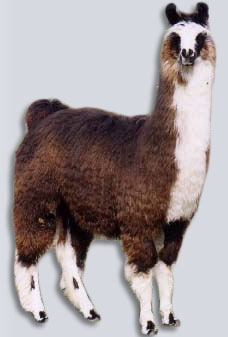 The llama is the tallest and strongest of the lamoids. Adults weigh between 113-250kg and measure 1-1.10m at the shoulder. There are two different species - the woolly type (cha'ku) and the wool less type (q'ara). The distinguishing feature (other than their size) between a llama and an alpaca is their banana-shaped ears. While used for packing, transport and fibre, these lamoids were killed by the Inca's in the 14th Century as sacrificial offerings. Today they are farmed for their fibre and used as pack animals. In South America they are also a source of food, transport and fuel (dried pellets for heating).
The llama is the tallest and strongest of the lamoids. Adults weigh between 113-250kg and measure 1-1.10m at the shoulder. There are two different species - the woolly type (cha'ku) and the wool less type (q'ara). The distinguishing feature (other than their size) between a llama and an alpaca is their banana-shaped ears. While used for packing, transport and fibre, these lamoids were killed by the Inca's in the 14th Century as sacrificial offerings. Today they are farmed for their fibre and used as pack animals. In South America they are also a source of food, transport and fuel (dried pellets for heating).
Guanaco
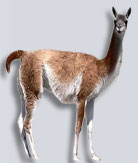 The guanaco is the second largest lamoid. They weigh between 100 and 120kg and stand 1.1-1.15m at the shoulder. There are 4 sub-species broadly distributed throughout South America. Their habitat ranges from sea-level to 4600m up into the Andes mountains. They are uniform in colour with a dark brown upper body, neck and limbs, and a whitish underside on the neck and belly region. Like the vicuna, these animals have not been domesticated and run wild in their native habitat of South America. Some domesticated animals are used as pack animals.
The guanaco is the second largest lamoid. They weigh between 100 and 120kg and stand 1.1-1.15m at the shoulder. There are 4 sub-species broadly distributed throughout South America. Their habitat ranges from sea-level to 4600m up into the Andes mountains. They are uniform in colour with a dark brown upper body, neck and limbs, and a whitish underside on the neck and belly region. Like the vicuna, these animals have not been domesticated and run wild in their native habitat of South America. Some domesticated animals are used as pack animals.
Alpaca
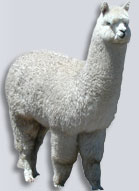 Adult alpacas weigh between 60 and 90kg and measure 80-95cm at the shoulder. With the exception of the vicuna, they are the finest fleece producers of all the lamoids. There are two types of alpaca - the huacaya (wa-ky-uh) and the suri (soo-ree). The huacaya has a sheep-like fleece that is crimped with independent staples. The suri carries a silky soft-handling dense locking fleece that moves freely. Alpacas come in a range of natural colours from white through to black. Alpaca fibre is considered a luxury fibre, and while most farms outside of South America specifically farm them for their fibre, in their native country they are also used to provide meat and leather, and their pellets are dried and used for fuel.
Adult alpacas weigh between 60 and 90kg and measure 80-95cm at the shoulder. With the exception of the vicuna, they are the finest fleece producers of all the lamoids. There are two types of alpaca - the huacaya (wa-ky-uh) and the suri (soo-ree). The huacaya has a sheep-like fleece that is crimped with independent staples. The suri carries a silky soft-handling dense locking fleece that moves freely. Alpacas come in a range of natural colours from white through to black. Alpaca fibre is considered a luxury fibre, and while most farms outside of South America specifically farm them for their fibre, in their native country they are also used to provide meat and leather, and their pellets are dried and used for fuel.
Vicuna
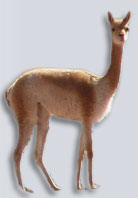 The vicuna are not domesticated and run wild throughout South America. At one point they became close to extinction, but with protection from the South American Government, numbers have significantly increased. They roam the highlands (puna) of South America, and live between 4200m and 4800m above sea-level in the Andes mountains. They are the smallest and finest fibred lamoid. They stand at 80-95cm and weigh between 45-55kg. They have a cinnamon coloured coat, white under parts, and a pale cinnamon face. There are two species - the Peruvian and the Argentinean. The Peruvian species is distinctive from the Argentinean species by the bib of white hair on the chest. While vicuna produce an exceptionally fine fibre (once reserved only for Royal members of the Inca empire) they are difficult to farm, can only be shorn once every two years, and require around 42 fleeces to make one suit.
The vicuna are not domesticated and run wild throughout South America. At one point they became close to extinction, but with protection from the South American Government, numbers have significantly increased. They roam the highlands (puna) of South America, and live between 4200m and 4800m above sea-level in the Andes mountains. They are the smallest and finest fibred lamoid. They stand at 80-95cm and weigh between 45-55kg. They have a cinnamon coloured coat, white under parts, and a pale cinnamon face. There are two species - the Peruvian and the Argentinean. The Peruvian species is distinctive from the Argentinean species by the bib of white hair on the chest. While vicuna produce an exceptionally fine fibre (once reserved only for Royal members of the Inca empire) they are difficult to farm, can only be shorn once every two years, and require around 42 fleeces to make one suit.
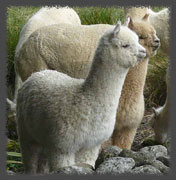
|
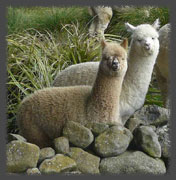
|
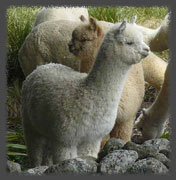
|
 |
|

|

|